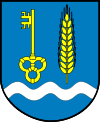Ciechanów
Ciechanów [t͡ɕeˈxanuf] (![]()
Ciechanów | |
|---|---|
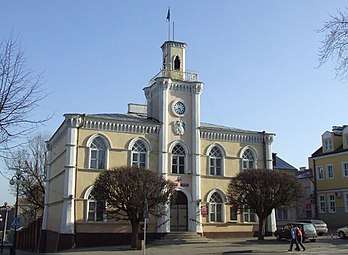 Town Hall | |
 Flag 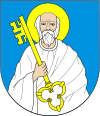 Coat of arms | |
 Ciechanów 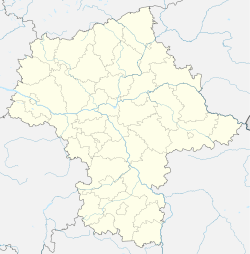 Ciechanów | |
| Coordinates: 52°52′N 20°38′E | |
| Country | |
| Voivodeship | Masovian |
| County | Ciechanów County |
| Gmina | Ciechanów (urban gmina) |
| Established | 11th century |
| City rights | 1400 |
| Government | |
| • Mayor | Krzysztof Kosiński (PSL) |
| Area | |
| • Total | 32.51 km2 (12.55 sq mi) |
| Highest elevation | 151 m (495 ft) |
| Lowest elevation | 116 m (381 ft) |
| Population (2018) | |
| • Total | 44,209[1] |
| Time zone | UTC+1 (CET) |
| • Summer (DST) | UTC+2 (CEST) |
| Postal code | 06-400 to 06-413 |
| Area code(s) | +48 023 |
| Car plates | WCI |
| Website | www.umciechanow.pl |
History
The settlement is first mentioned in a 1065 document by Bolesław II the Bold handing the land over to the church. The medieval gord in Ciechanów numbered approximately 3,000 armed men,[2] and together with the province of Mazovia, it probably became part of the Polish state in the late 10th century.
In 1254, Ciechanów is mentioned as the seat of a castellany (Rethiborius Castellanus de Techanow (Racibor, Kasztelan Ciechanowa)). In 1400 Janusz I of Czersk granted Ciechanów town privileges.[3] The area eventually become a separate duchy with Casimir I of Warsaw using the title "dominus et heres lub dominus et princeps Ciechanoviensis." In the Middle Ages, the defensive gord of Ciechanów protected northern Mazovia from raids of Lithuanians, Yotvingians, Old Prussians and later, the Teutonic Knights. It is not known when it was granted a town charter. This must have happened before 1475, as a document from that year, issued by Duke Janusz II of Warsaw, states that Ciechanów has a Chełmno town charter.
In the period between the 14th and 16th centuries, Ciechanów prospered with the population reaching 5,000. In the late 14th century, Siemowit III, Duke of Masovia, began construction of a castle, while his son Janusz I of Warsaw invited the Augustinians, who in the mid-15th century began construction of a church and an abbey. In 1526, together with all Mazovia, Ciechanów was incorporated to the Kingdom of Poland. It was a royal city of Poland, the seat of the Land of Ciechanów, a separate administrative unit within the Masovian Voivodeship in the Greater Poland Province of the Polish Crown.
The town was handed over to Bona Sforza, as her dowry. Ciechanów prospered until the Swedish invasion of Poland (1655-1660), when the town was burned and ransacked.
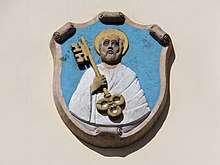
After the second partition of Poland (1793), Ciechanów briefly became seat of a newly created voivodeship. In 1795, it was annexed by the Kingdom of Prussia, and reduced to the status of a provincial town in Przasnysz county. In 1806, during the Napoleonic Wars, Ciechanów was ransacked and destroyed. In 1807 it became part of the short-lived Polish Duchy of Warsaw. Since 1815, the town belonged to Russian-controlled Congress Poland. Its residents actively supported Polish rebellions. In the late 19th century, Ciechanów emerged as a local trade and industry center. In 1864, a brewery was opened, in 1867 it became seat of a county, in 1877 a rail station of the Vistula River Railroad was completed, and in 1882 a sugar refinery was opened. The period of prosperity was short, as during World War I, Ciechanów was almost completely destroyed.
In the Second Polish Republic, Ciechanów remained seat of a county in Warsaw Voivodeship. In 1938, its population was 15,000, and the town was a military garrison, home to the 11th Uhlan Regiment of Marshall Edward Smigly-Rydz.
World War II
.jpg)
Ciechanów was captured by the Wehrmacht on the night of September 3/4, 1939. The town was annexed by Nazi Germany and was known as Zichenau in German. It was the capital of Regierungsbezirk Zichenau, a new subdivision of the Province of East Prussia. The vast majority of the Polish and Jewish population was seen as racially inferior and Germany planned its eventual annihilation.[4] The Einsatzgruppe V entered the city on September 10, 1939, and carried out first mass arrests among local Polish intelligentsia.[5] Residents were imprisoned in Gestapo jails established in municipal buildings and the city hall.[5] The Germans carried out mass searches of Polish and Jewish homes, offices and organizations, as well as synagogues, which were desecrated and looted.[6] Several hundred Poles were transported from the jail in Ciechanów and murdered in large massacres in the nearby village of Ościsłowo as part of Intelligenzaktion.[7] Also local disabled people were murdered in Ościsłowo, on February 20, 1940.[8] Local teachers were arrested in October and November 1939, and deported to the Soldau concentration camp, where they were murdered in December 1939, and some were also murdered in the Mauthausen concentration camp.[9]
Poles were also subjected to expulsions. Around 600 people were expelled in December 1939, further expulsions were carried out in subsequent years.[10] In Ciechanów, the Germans also organized a transit camp for Poles deported for forced labor to the areas of Klaipeda, Tilsit (Sovetsk) and Königsberg (Kaliningrad).[11]
Before World War II, Ciechanów was home to a large Jewish community of 1,800, but during the Nazi German occupation, in November 1942, the majority of the Jewish community were transported to the Red Forest (Czerwony Bór) northeast of town and murdered in a mass shooting.[12] During the war many Polish Jews and resistance fighters were executed by the Germans in the castle.
On January 17, 1945, Ciechanów was captured from Nazi Germany by the Red Army, and was restored to Poland after the war.
Monuments and sights
- Castle of the Mazovian Dukes from the 14th century, alongside the Łydynia river
- Farska Hill – fortified settlement from the 7th century with a Neo-Gothic belfry from the 19th century
- Church of the Nativity of the Virgin Mary, Late Gothic building from the 16th century
- Monastery Augustinian Church from the 16th and 18th centuries
- City Hall from the 19th century
- Muzeum Szlachty Mazowieckiej (Museum of Mazovian Nobility)
- Parish cemetery which has functioned since 1828
- Park Nauki Torus ("Torus Science Park") with the hyperboloid water tower, built in 1972
 Castle tower
Castle tower Church of the Nativity of the Virgin Mary
Church of the Nativity of the Virgin Mary- Augustinian Church
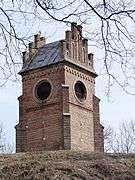 Belfry on Farska Góra
Belfry on Farska Góra- Museum of Mazovian Nobility
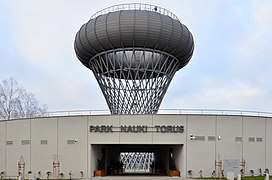 Torus Science Park
Torus Science Park
Economy
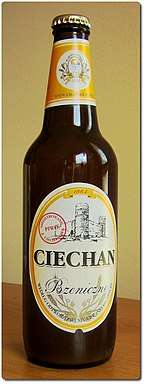
The Browar Ciechan brewery is located in the town.
Education
- Państwowa Wyższa Szkoła Zawodowa
- Wyższa Szkoła Biznesu i Zarządzania
Transport
Through the town are leading two national roads, numbered 50 and 60; and three voivodship roads, numbered 615, 616, 617. Just 25 km away to the West there is the national road number 7, a part of the E77 European route.
The Ciechanów railway station is on the Warsaw - Gdańsk railway. However, the Warsaw-Gdańsk-Gdynia express train, colloquially referred as 'Pendolino', does stop here. Other trains offer connection to Warsaw, Olsztyn, Gdańsk, Gdynia, Kołobrzeg, Kraków and Łódź.
Sports
Ciechanów is home to handball club Jurand Ciechanów, which competes in the I liga (Polish second tier), and to football club MKS Ciechanów, which competes in the lower divisions.
Notable people
- Jan Kazimierz Krasiński (1607–1669), Polish official and nobleman, royal secretary of Polish King Sigismund III Vasa
- Ludwik Krasiński (1609–1644), Polish royal courtier and official
- Zygmunt Krasiński (1812–1859), Polish poet, considered one of Poland's Three Bards
- Maria Konopnicka (1842–1910), Polish poet and novelist
- Aleksander Świętochowski (1849–1938), Polish writer, educator, and philosopher
- Stefan Żeromski (1864–1925), Polish novelist and dramatist
- Ignacy Mościcki (1867–1946), Polish chemist, politician, and President of Poland
- Roza Robota (1921–1945), Polish-Jewish resistance member during World War II
- Mieczysław Jagielski (1924–1997), Polish politician and economist
- Zbigniew Siemiątkowski (born 1957), Polish politician
- Dorota Rabczewska (Doda) (born 1984), Polish singer-songwriter
- Kasia Struss (born 1987), Polish model
- Quebonafide (born 1991), Polish rapper
- Adam Morawski (born 1994), Polish handball player, member of the Polish national handball team
- Ania Ahlborn, Polish-American novelist
International relations
Twin towns – Sister cities
Ciechanów is twinned with:[13]




References
- https://warszawa.stat.gov.pl/vademecum/vademecum_mazowieckie/portrety_gmin/ciechanowski/1402011_ciechanow.pdf
- Bogusław Gierlach, Zapiski Ciechanowskie, vol. II p. 9-12, MOBN Ciechanów 1977; and Studia nad archeologią średniowiecznego Mazowsza, Warsaw 1975, p. 24)
- W. Górczyk, Ciechanów- Lokacja i Geneza herbu, In Tempore, Uniwersytet Mikołaja Kopernika,s.3. "Archived copy" (PDF). Archived from the original (PDF) on January 23, 2012. Retrieved May 12, 2010.CS1 maint: archived copy as title (link)
- Jan Grabowski; Zbigniew R. Grabowski (2004). Germans in the Eyes of the Gestapo: The Ciechanów District, 1939–1945. Cambridge University Press: Contemporary European History, No 13. pp. 21–43; page 25: "The majority of the Poles and Jews of the Regierungsbezirk Zichenau were perceived by the Nazi authorities as undesirable elements, and were to be resettled and, eventually, annihilated."
- Maria Wardzyńska, Był rok 1939. Operacja niemieckiej policji bezpieczeństwa w Polsce. Intelligenzaktion, IPN, Warszawa, 2009, p. 112 (in Polish)
- Maria Wardzyńska, Był rok 1939. Operacja niemieckiej policji bezpieczeństwa w Polsce. Intelligenzaktion, p. 122
- Maria Wardzyńska, Był rok 1939. Operacja niemieckiej policji bezpieczeństwa w Polsce. Intelligenzaktion, p. 226
- Maria Wardzyńska, Był rok 1939. Operacja niemieckiej policji bezpieczeństwa w Polsce. Intelligenzaktion, p. 236
- Maria Wardzyńska, Był rok 1939. Operacja niemieckiej policji bezpieczeństwa w Polsce. Intelligenzaktion, p. 228, 231
- Maria Wardzyńska, Wysiedlenia ludności polskiej z okupowanych ziem polskich włączonych do III Rzeszy w latach 1939-1945, IPN, Warszawa, 2017, p. 384, 392 (in Polish)
- Maria Wardzyńska, Wysiedlenia ludności polskiej z okupowanych ziem polskich włączonych do III Rzeszy w latach 1939-1945, p. 405
- D.P. (February 13, 2007). "Międzynarodowy Dzień Ofiar Holokaustu: Zagłada ciechanowskich Żydów". Historia. Tygodnik Ciechanowski. Retrieved June 15, 2013.
- "Ciechanów Twin towns". Urząd Miasta Ciechanów. Archived from the original on July 29, 2013. Retrieved July 29, 2013.
- "Ville de Meudon – Villes jumelles". Ville de Meudon. Archived from the original on May 7, 2013. Retrieved September 11, 2016.
External links
| Wikimedia Commons has media related to Ciechanów. |
- Wojciech Górczyk, Ciechanów – zarys dziejów do XV w., Kultura i Historia, Uniwersytet Marii Curie Skłodowskiej w lublinie,19/2011, ISSN 1642-9826
- Official homepage
- Architecture of Ciechanow (only in Polish)
- Czas Ciechanowa (Local weekly magazine, local press)
- Jewish Community in Ciechanów on Virtual Shtetl
- Ciechanów city forum
- Ciechanow website www.ciechanowonline.pl - all you need to know about Ciechanow, including a contemporary gallery of the city
- Site dedicated to preserving the memory of Ciechanów's Jewish community, including an English translation of the memorial book
- Website of Ciechanow City www.eciechanow.pl – City news, history of Ciechanow, information where you can eat, sleep and dance
- Castle of the Dukes of Mazovia in Ciechanów (en)
- Museum of the Mazovian Nobility (en)

